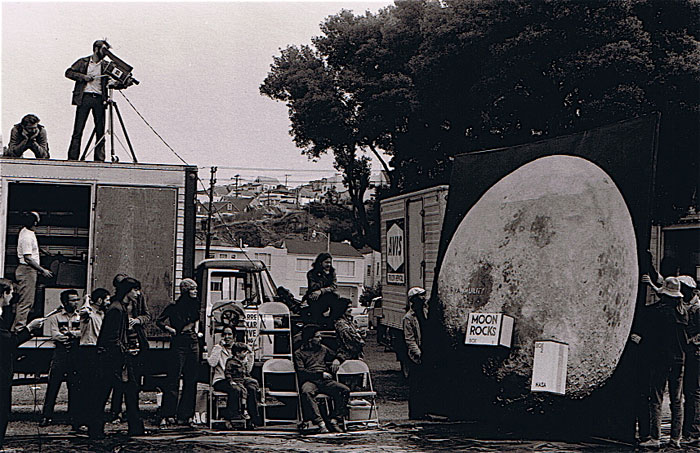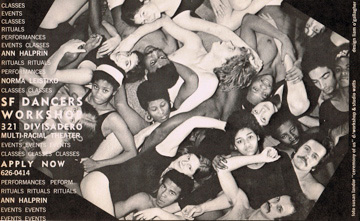
Return Trip event at Precita Park, San Francisco, 1969
In the late 1960s, artists were moving beyond imagery to sound and action, including street theatre and experiments with music and film.
"A lot of artists were doing things that involved everyday actions – somewhere between life and theatre,” Charles Amirkhanian says of the times. “People were trying to create change in their work. The air was filled with unrest – the Watts riots, the assassinations of 1968, the Democratic Convention in Chicago – and the students protesting on campuses. Everyone was looking for a better way to co-exist. I believe that Liam was drawn toward futurism, as a means of saying there was another approach. Perhaps things couldn't turn around overnight – but the future held the answer."
In 1969, KQED-TV broadcast Liam’s Return Trip, an ecological performance piece sponsored by the Dilexi Gallery as part of a day-long event that included the creation of a Geodesic Dome in Precita Park. Liam’s work, which was accompanied by the electronic music of John Payne, featured moon rocks being returned to the moon, while the litter that had been left by the NASA crew is collected. Liam’s set and instructions for the event were as follows:
“A 40’ by 100’ strip of black plastic stretches across the width of the park. At one end of this strip a 12’ by 12’ photo of the moon is supported on a frame (this is until Mr. America approaches Luna to redeposit the rocks and is then raised to a vertical position by the dancers). During the return of the rocks, the Star Spangled Banner is played backwards (with chorus). Following the rock scene, the moon is lowered to a horizontal position and everyone present has lunch on the moon. After lunch, Mr. and Mrs. America & Child are seen driving off in their station wagon…”
The event featured Ralph Silver and Nancy Fish (and child) as Mr. and Mrs. America, and involved Ann Halprin’s Dancers’ Workshop. Approximately 300 people participated in the event, which Liam later wrote was, “…ecologically sound, since one of the purposes was to replace the moon rocks rather than remove them, pick up the litter left by the NASA team, and have enough time for lunch before returning to earth.”
Space Station, an unrealized project from the period, with an amazing similarity to internet sites such as YouTube, utilized video cameras and monitors. In his proposal for the project, Liam wrote:
“My personal involvement grew out of the awareness that the media, because it is having such a persuasive impact on our culture, represents a potential art form which should be experimented with, and on another level, not unrelated, is the question of satisfying young people especially from the ghetto, that their energy, instead of being exclusively drained off by political anarchy, could take a creative form in challenging the new technology, thereby gaining some control over it.
The plan is to provide the environment where these two forces can meet and explore together both the aesthetic and the social aspects of this tremendous power which so far has been left largely in the hands of commercial interests. While these have placed most of the emphasis on technical ingenuity, we would put our emphasis more on creative imagination.
This might be presented in a storefront downtown or in an empty room in a local museum. I have discussed such a possibility with one of the directors of the Oakland Museum of Art, whose experience with the above problem leads me to believe that such a space would be made available.
The area designated for the project would be called a SPACE STATION where experiments with audio and video space could be carried on and levels of awareness concerning the borders and boundaries of one’s body and various objects would pass through changes determined by the individual and would help him and the experimenter to discover implications of the image with regard to control of the MEDIA. This experience would confirm people in their decision to take an active role in determining the CONTENT of the media and to provide contexts, having their own, in which others can, who desire, do the same.”
Liam applied to the Merrill Foundation for funding, and William Burroughs offered advice by letter from London:
“Dug the moon portrait which I had not seen. The project sounds useful and workable and I wish you luck with the Merrill Foundation. Perhaps you would get some ideas from my article in FREEP which was entitled Cut Ups as Underground Weapon or from the sections in The Job dealing with tape recorders. I think that tape recorder techniques would adapt very well to the project you have in mind. Please let me know how you make out.”
Nanos Valaoritis, then Professor of World Literature and Creative Writing at San Francisco State College, was among those who wrote a letter in support for the project:
“I am very interested in Liam O’Gallagher’s project which seems to me an opening for the culturally suppressed individual, living in vast modern technological societies, to project himself as an image in space and time and to become aware of his potentialities as an ‘expressor’ and not only as an ‘ingressor’ which eventually turns him into an ‘aggressor’ in many bizarre and irrelevant ways.”
In 1969, Liam collaborated with choreographer Anna Halprin on Ceremony of Us, which brought together African-American dancers from L.A.’s Studio Watts Dance Group, and dancers from Halprin’s San Francisco Dancers’ Workshop, who were primarily white. The show had its premiere at the opening of the Mark Taper Forum in Los Angeles.
"Rehearsals were highly charged emotional encounters,” Liam later recalled. “They would last from two to three hours. My job was to help Ann resolve not only borders, but barriers and boundaries of centuries of fear, mistrust and hate due to inequality and ignorance. It was painful. We were all there for various reasons, but we were intent on proving that we could and would use each other as a bridge. The object was not to make something that was aesthetically pure, but to create something that was real and would prove itself over time. The nice thing of course was there was a maximum allowance for improvising, and I think this was Ann's greatest contribution to modern dance. She allowed the form to emerge rather than imposing it.”
"The first project I worked on with Liam,” recalls Charles Amirkhanian, “was a work by the choreographer Anna Halprin, who took choreography apart and put it back together in a new way in the 1960s and 70s. We worked together on A Ceremony of Us, a performance at the Mark Taper Forum in Los Angeles. I was there as the composer of the music, though what she ultimately needed was someone to put together a collage of sounds relating to the performance, which I combined with things such as horn sounds I brought with me. Liam noted how fascinating the interaction between these dancers were, and so we recorded their conversations and turned it into a sound collage, so that they moved to the sounds of the encounter. We created a record, which was funded by Jim Newman, who had Dilexi Gallery, the first gallery in San Francisco with white walls, which was located above the Jazz Workshop in North Beach.”
 Flyer for San Francisco Dancer's Workshop
Flyer for San Francisco Dancer's Workshop
with image of dancers in Ceremony of Us, 1969
|
Introduction to the Television presentation:
You are about to be a witness to a film which reveals a lifestyle of two groups of young people, black and white, who have come together – with the intention of working through barriers that have kept Americans separate. What you will see is an account of that experience – of its trials, joys and tribulations.
Their medium of communication is dance, but they are not professionals. This is an authentic statement of real people, living through a life situation.
I’m proud to have been part of it. This is an expression of creative growth that is not only possible, but vital to change that must come about on planet Earth. If you find yourself identifying with what you see, it will truly be a ceremony involving all of us.
|